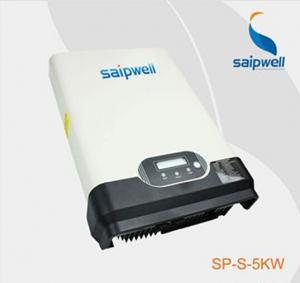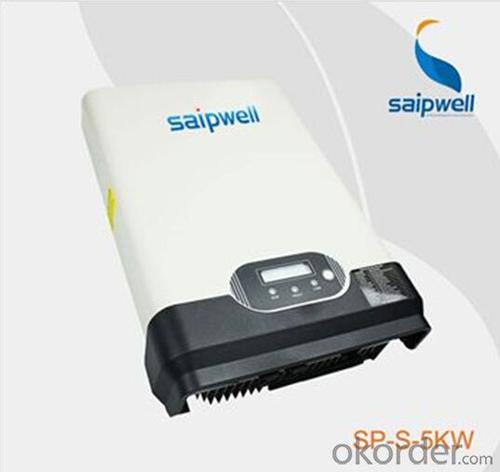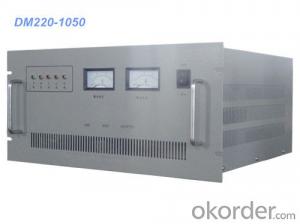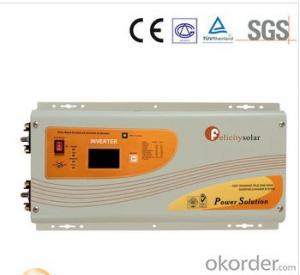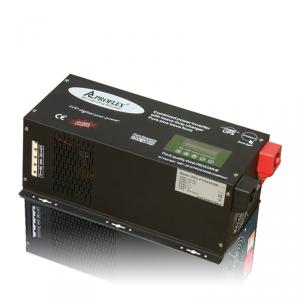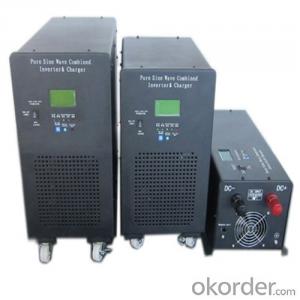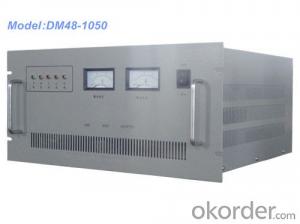10kVA Solar Inverter 5kW 220V 2024 Newest Pure Sine Wave
- Loading Port:
- China main port
- Payment Terms:
- TT or LC
- Min Order Qty:
- 5000 watt
- Supply Capability:
- 3000000 watt/month
OKorder Service Pledge
OKorder Financial Service
You Might Also Like
1. Structure of Solar Inverter 5kw 220v 2015 Newest Pure Sine Wave Description
The inverter series is an electronic product that has been designed and built to take low DC woltage power from batteries and convert it to
standard AC power like the current you have at home.
The Inverter series is a DC-to-AC with auto line-to-battery transfer and intergrated charging system. Inverter series powers from ACpower
and DC source, serving as an extended run UPS. When AC cable is connected to a wall socket, utility power goes to connected equipment
and/or charges the battery set via charging system. In Inverter mode, the Inverter series automatically converts battery energy into AC power
for backing up the connected devices
2. Main Features of Solar Inverter 5kw 220v 2015 Newest Pure Sine Wave
• Transformerless design, high efficiency (Max. 97.5%, Euro. 96.6%)
• High MPPT accuracy( >99.9%)
• Wide DC input range(120-590 Vdc), compatible with different module technologies
• Easy to wire, install and operate
• IP 65 design, suitable for indoor and outdoor installation
• 5 years warranty(10~25 years as option)
• Multi MPPT channels
3. Solar Inverter 5kw 220v 2015 Newest Pure Sine Wave Images
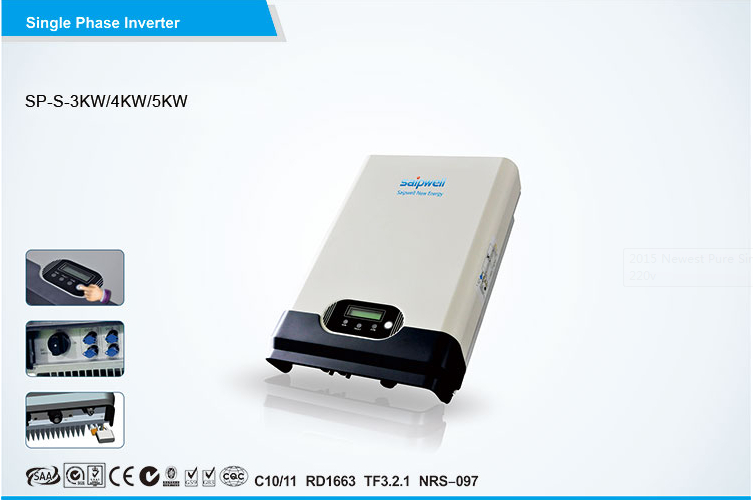

4. Solar Inverter 5kw 220v 2015 Newest Pure Sine Wave Specification
窗体顶端 Model窗体底端 | SP-S-3kw | SP-S-4kw | SP-S-5kw |
Input (DC) | |||
Max. DC voltage [V] | 590 | ||
MPPT DC voltage Range [V] | 120-500 | ||
Turn off DC voltage [V] | 120 | ||
Number of MPP Trackers | 2 | ||
Max. DC Current(A/B)[A] | 18/18 | ||
DC-Connection | MC4 | ||
Output (AC) | |||
Max. AC Power [W] | 3300 | 4400 | 4800 |
Nominal AC Power [W] | 3000 | 4000 | 4600 |
Max. AC Current [A] | 14.4 | 19 | 21.0 |
Nominal AC Current [A] | 13 | 17.4 | 20 |
Grid voltage Range | According to VDE 0126-1-1, RD1663, ENEL2010,C10/11,G83/1, AS4777 | ||
Grid Frequency Range | According to VDE 0126-1-1, RD1663, ENEL2010,C10/11,G83/1, AS4777 | ||
Power Factor | 0.99 (>30% of Full Load) | ||
THD(AC Output Current ) | <2% | ||
AC Connector | Plug-in connector | ||
Power Consumption | |||
Own Consumption in Operation [W] | 45 | 50 | 50 |
Power Consumption at Night [W] | 0 | ||
Power Consumption at Standby [W] | 6 | ||
Efficiency | |||
Max. Efficiency (at 360VDC) | 97.5% | 97.6% | 97.6% |
Euro. Efficiency (at 360VDC) | 96.6% | 97.0% | 97.0% |
MPPT Efficiency | 99.9% 窗体底端 | ||
5. FAQ of Solar Inverter 5kw 220v 2015 Newest Pure Sine Wave
Q1:Can we visit your factory?
A1:Sure,welcome at any time,seeing is believing.
Q2:Which payment terms can you accept?
A2:T/T,L/C,Moneygram,Paypal are available for us.
- Q: How does a solar inverter handle anti-islanding protection?
- A solar inverter handles anti-islanding protection by constantly monitoring the grid voltage. If the grid goes down or voltage drops below a certain threshold, the inverter automatically disconnects from the grid to prevent feeding power back into the grid during an outage. This ensures the safety of utility workers and prevents damage to the grid.
- Q: What is the role of a maximum power control feature in a solar inverter?
- The role of a maximum power control feature in a solar inverter is to optimize the energy output of the solar panels by constantly tracking and adjusting the operating point to ensure that the system operates at its maximum power point (MPP). This feature helps to increase the overall efficiency of the solar system and maximize the amount of energy that can be harvested from the sun.
- Q: Can a solar inverter be used with different types of grounding configurations?
- Yes, a solar inverter can be used with different types of grounding configurations. However, it is important to ensure that the grounding configuration of the inverter is compatible with the specific electrical system it is being connected to. It is recommended to consult the manufacturer's guidelines and local electrical codes to determine the appropriate grounding configuration for safe and efficient operation.
- Q: How does a solar inverter handle voltage drop?
- A solar inverter handles voltage drop by continuously monitoring the voltage levels from the solar panels. If it detects a drop in voltage, it adjusts its internal voltage regulation mechanisms to maintain a stable output voltage. This ensures that the inverter can efficiently convert the incoming DC power from the solar panels into usable AC power without any significant loss or disruption caused by voltage fluctuations.
- Q: Can a solar inverter convert DC power to AC power during a power outage?
- No, a solar inverter cannot convert DC power to AC power during a power outage. Solar inverters rely on the grid for synchronization and voltage reference, so when there is a power outage, the inverter automatically shuts down to prevent back-feeding electricity into the grid and endangering utility workers.
- Q: How does a solar inverter convert DC to AC?
- A solar inverter converts direct current (DC) to alternating current (AC) by using a two-step process. First, it takes the DC electricity generated by solar panels and passes it through a device called a rectifier, which converts the DC power into a high-frequency AC signal. Then, this AC signal is passed through an inverter circuit that converts the high-frequency AC into standard frequency AC, typically 50 or 60 Hz, suitable for supplying power to household appliances and the electrical grid.
- Q: Can a solar inverter be used with solar-powered desalination systems?
- Yes, a solar inverter can be used with solar-powered desalination systems. A solar inverter is essential in converting the direct current (DC) power generated by solar panels into alternating current (AC) power that can be used to operate the desalination system. This allows for the efficient utilization of solar energy for powering the desalination process.
- Q: Can a solar inverter be used in three-phase systems?
- Yes, a solar inverter can be used in three-phase systems. In fact, three-phase solar inverters are commonly used in commercial and industrial applications where a three-phase power supply is available. These inverters are designed to convert the DC power generated by solar panels into AC power suitable for use in three-phase systems.
- Q: Can a solar inverter be used in a community solar project?
- Yes, a solar inverter can be used in a community solar project. A solar inverter is an essential component that converts the direct current (DC) generated by solar panels into alternating current (AC) for use in homes and businesses. In a community solar project, multiple participants can benefit from a shared solar installation, and each participant can have their own solar inverter to convert the DC energy into usable AC power.
- Q: Can a solar inverter be used in extreme weather conditions?
- Yes, solar inverters are designed to withstand a wide range of weather conditions, including extreme heat, cold, humidity, and even harsh environmental factors. They are built to be durable and reliable, ensuring their functionality and performance in various climates and weather conditions.
Send your message to us
10kVA Solar Inverter 5kW 220V 2024 Newest Pure Sine Wave
- Loading Port:
- China main port
- Payment Terms:
- TT or LC
- Min Order Qty:
- 5000 watt
- Supply Capability:
- 3000000 watt/month
OKorder Service Pledge
OKorder Financial Service
Similar products
Hot products
Hot Searches
Related keywords
